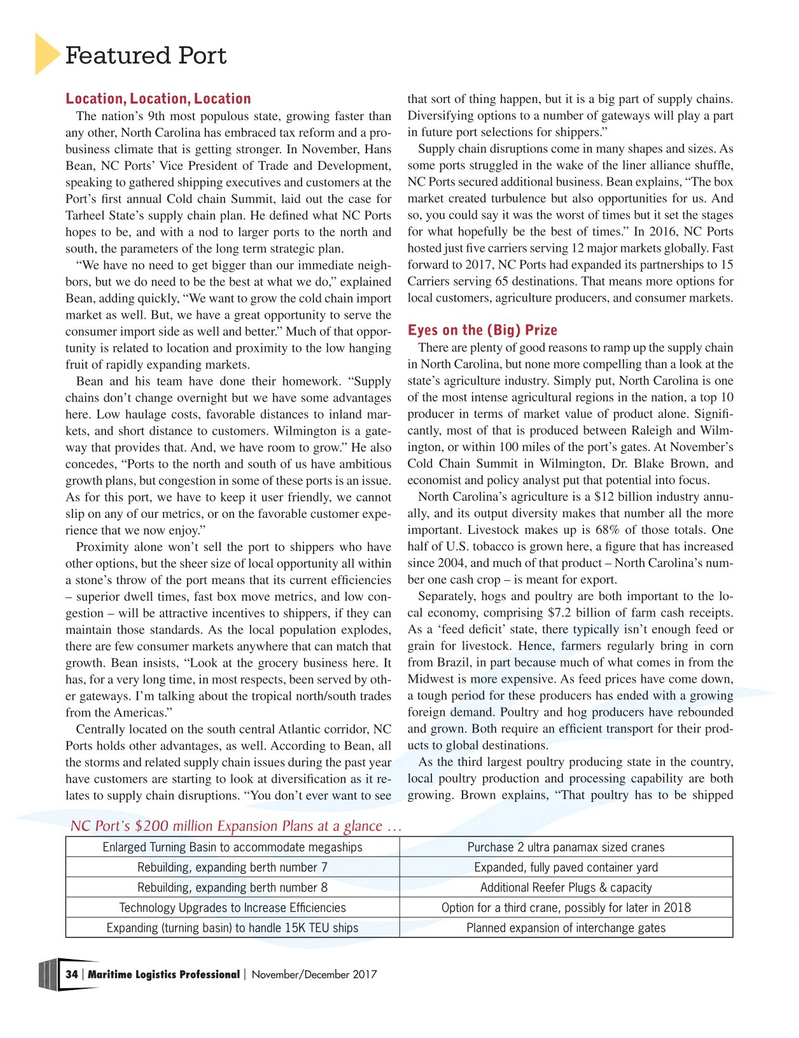
Page 34: of Maritime Logistics Professional Magazine (Nov/Dec 2017)
GREEN PORTS
Read this page in Pdf, Flash or Html5 edition of Nov/Dec 2017 Maritime Logistics Professional Magazine
Featured Port that sort of thing happen, but it is a big part of supply chains.
Location, Location, Location
The nation’s 9th most populous state, growing faster than Diversifying options to a number of gateways will play a part any other, North Carolina has embraced tax reform and a pro- in future port selections for shippers.” business climate that is getting stronger. In November, Hans Supply chain disruptions come in many shapes and sizes. As
Bean, NC Ports’ Vice President of Trade and Development, some ports struggled in the wake of the liner alliance shuffe, speaking to gathered shipping executives and customers at the NC Ports secured additional business. Bean explains, “The box
Port’s frst annual Cold chain Summit, laid out the case for market created turbulence but also opportunities for us. And
Tarheel State’s supply chain plan. He defned what NC Ports so, you could say it was the worst of times but it set the stages hopes to be, and with a nod to larger ports to the north and for what hopefully be the best of times.” In 2016, NC Ports south, the parameters of the long term strategic plan. hosted just fve carriers serving 12 major markets globally. Fast
Paul Cozza, “We have no need to get bigger than our immediate neigh- forward to 2017, NC Ports had expanded its partnerships to 15
NC Ports Executive Director bors, but we do need to be the best at what we do,” explained Carriers serving 65 destinations. That means more options for
Bean, adding quickly, “We want to grow the cold chain import local customers, agriculture producers, and consumer markets.
market as well. But, we have a great opportunity to serve the
Eyes on the (Big) Prize consumer import side as well and better.” Much of that oppor- tunity is related to location and proximity to the low hanging There are plenty of good reasons to ramp up the supply chain fruit of rapidly expanding markets. in North Carolina, but none more compelling than a look at the
Bean and his team have done their homework. “Supply state’s agriculture industry. Simply put, North Carolina is one chains don’t change overnight but we have some advantages of the most intense agricultural regions in the nation, a top 10 here. Low haulage costs, favorable distances to inland mar- producer in terms of market value of product alone. Signif- kets, and short distance to customers. Wilmington is a gate- cantly, most of that is produced between Raleigh and Wilm- way that provides that. And, we have room to grow.” He also ington, or within 100 miles of the port’s gates. At November’s concedes, “Ports to the north and south of us have ambitious Cold Chain Summit in Wilmington, Dr. Blake Brown, and growth plans, but congestion in some of these ports is an issue. economist and policy analyst put that potential into focus.
As for this port, we have to keep it user friendly, we cannot North Carolina’s agriculture is a $12 billion industry annu- slip on any of our metrics, or on the favorable customer expe- ally, and its output diversity makes that number all the more rience that we now enjoy.” important. Livestock makes up is 68% of those totals. One
Proximity alone won’t sell the port to shippers who have half of U.S. tobacco is grown here, a fgure that has increased other options, but the sheer size of local opportunity all within since 2004, and much of that product – North Carolina’s num- a stone’s throw of the port means that its current effciencies ber one cash crop – is meant for export.
– superior dwell times, fast box move metrics, and low con- Separately, hogs and poultry are both important to the lo- gestion – will be attractive incentives to shippers, if they can cal economy, comprising $7.2 billion of farm cash receipts. maintain those standards. As the local population explodes, As a ‘feed defcit’ state, there typically isn’t enough feed or there are few consumer markets anywhere that can match that grain for livestock. Hence, farmers regularly bring in corn growth. Bean insists, “Look at the grocery business here. It from Brazil, in part because much of what comes in from the has, for a very long time, in most respects, been served by oth- Midwest is more expensive. As feed prices have come down, er gateways. I’m talking about the tropical north/south trades a tough period for these producers has ended with a growing from the Americas.” foreign demand. Poultry and hog producers have rebounded
Centrally located on the south central Atlantic corridor, NC and grown. Both require an effcient transport for their prod-
Ports holds other advantages, as well. According to Bean, all ucts to global destinations.
the storms and related supply chain issues during the past year As the third largest poultry producing state in the country, have customers are starting to look at diversifcation as it re- local poultry production and processing capability are both lates to supply chain disruptions. “You don’t ever want to see growing. Brown explains, “That poultry has to be shipped
NC Port’s $200 million Expansion Plans at a glance …
Enlarged Turning Basin to accommodate megaships Purchase 2 ultra panamax sized cranes
Rebuilding, expanding berth number 7 Expanded, fully paved container yard
Rebuilding, expanding berth number 8 Additional Reefer Plugs & capacity
Technology Upgrades to Increase Effciencies Option for a third crane, possibly for later in 2018
Expanding (turning basin) to handle 15K TEU ships Planned expansion of interchange gates 34 Maritime Logistics Professional November/December 2017 | |

 33
33

 35
35
